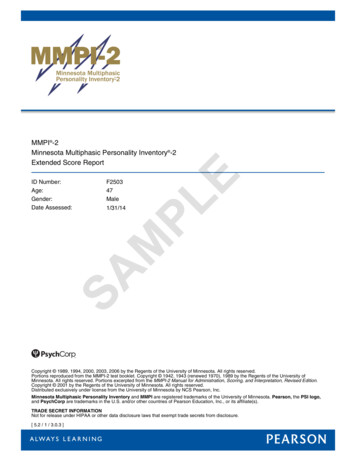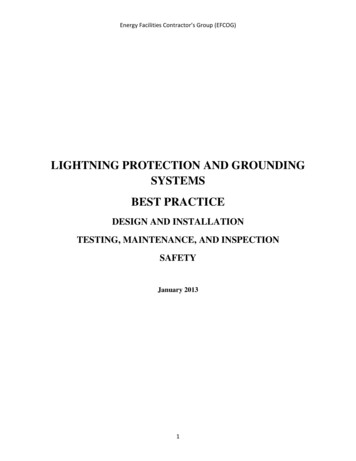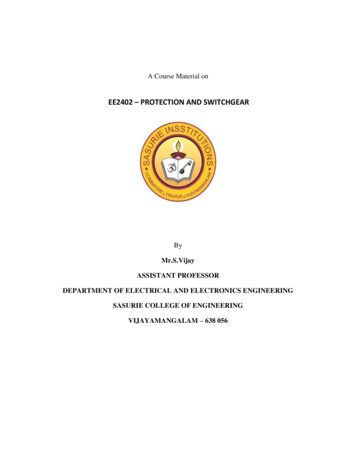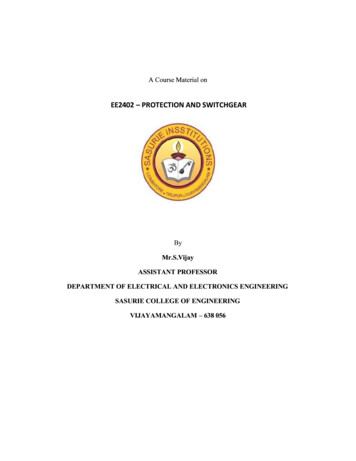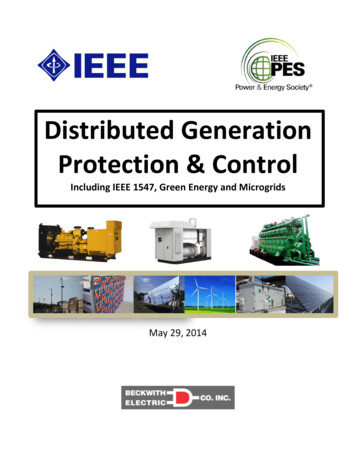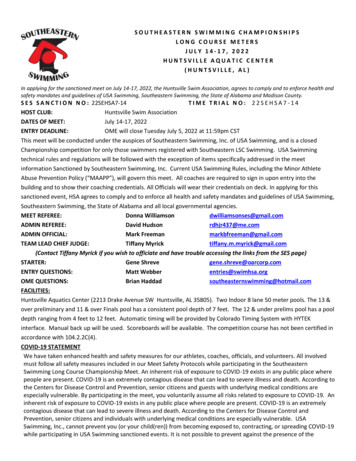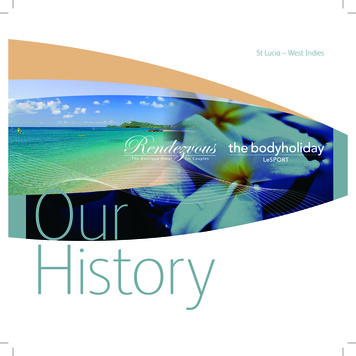
Transcription
100HthYISTOR1911-2011
It was on October 16, 1911, that the International Association of Dairy and Milk Inspectors held its firstmeeting. Thirty-five men from Australia, Canada, and the United States met at Milwaukee, Wisconsin,and started an organization which had just completed it fortieth year of continuous operation. Reprintedfrom the Journal of Milk and Food Technology, Volume 15, No. 1, 1952.1
2
AcknowledgmentsAt the 1999 Annual Meeting in Dearborn, Michigan, President JackGuzewich issued a call for an Association History to be written. A historydocument was not available and he felt that the turn of the century was anexcellent time to “take a look back” at the Association’s roots. He asked forassistance from the Past Presidents and long-time Members.Following Jack’s call, four Past Presidents volunteered to help reviewearly Journals and Annual Reports, to pull information from printedPresidential Addresses, to look at information and extract interesting details,and to write text that would capture the essence of the important contributions this Association made to enhance public health since 1911. As itturned out, two individuals, Harry Haverland and Earl Wright, carried thebulk of the weight in seeing the project through to fruition. In additionto Harry and Earl’s contributions, Jackie Runyan and David Tharp wrotesections to round out the history. Donna Bahun, Lucia Collison, DidiLoynachan, and Pam Wanninger from the Association office providedadditional assistance. Helene Uhlman contributed a woman’s perspectiveof her 30-plus years as a Member. Harold Bengsch and William LaGrangealso reviewed the draft manuscript and provided meaningful guidance. Toeveryone who contributed time, effort and expertise to this document, weare grateful to you. Thanks also to the individual Members who devotedtheir time and effort to the Association from that first Meeting in Milwaukeeto the present time.In observance of IAFP’s 100-Year Anniversary, an update of the historybook was undertaken. Lelani McDonald reviewed journals and writtenrecords of the Association from 2000 through 2010 and summarizedeach year to add to the already established written history. Jackie Runyanand David Tharp were involved in editing and Pam Wanninger andDonna Bahun provided proofing and layout services.The majority of information contained within this document wastaken from written, Presidential Addresses presented at Association AnnualMeetings. Because of relying heavily on these reports, some details of theAssociation history may have been overlooked.To everyone who reads the History of the International Association forFood Protection, we hope you will enjoy it and we hope you will learn aboutthe contributions the Association has made to improve the public’s healthfor over 100 years.Advancing Food Safety Worldwide 3
TABLE OF CONTENTSThe Early Years.5The ‘20s .8The ‘30s . 11The ‘40s . 15The ‘50s . 19The ‘60s . 22The ‘70s . 28The ‘80s .30The ‘90s . 34Third Millennium – The First Decade: 2000–2010 .40Pictures from the 100-Year Anniversary Calendar . 59Appendix A — Founding Members . 61Appendix B — First Annual Report, Table of Contents . 62Appendix C — A Woman’s Journeyy . 64Appendix D — Our Heritage – 50 Years in Retrospect. 66Appendix E — Celebrating 100 Years of IAFP . 78Appendix F — Past Presidents . 94Appendix G — Past Annual Meetings and Locations . 95Appendix H — Publication Editors . 96Appendix I — 2011 Executive Board . 98Appendix J — Association Staff.f994
HISTORYThe Early YearsWho we are today as an organization is largely a result of how we startedand how we have adapted through the years to changes in the world. Howand why we started was summed up in the first Presidental Address, readat the first annual convention of what was to become, after almost ninedecades, the International Association for Food Protection. The followingaccount of the early years draws heavily on that address of 1912, much ofwhich is worth repeating because the statements in it were to hold truefor so many years to come.In 1911, a group of men engaged in advocating improved cleanlinessin milk production — men whose purpose was “producing and marketingthe products of the dairy cow” — banded together because of their convictionthat improvements were needed in the nation’s milk supply. The problemwas not one of quantity; the supply of milk was ample for the needs of thepopulation. Rather, the need was for better quality — bluntly, a more cleanproduct.The responsibility for improvement rested on producers and consumersalike, and both had fallen short: Although producers were responsible forsetting a high standard of cleanliness, many had not done so, and althoughconsumers should have been willing to pay more for clean milk than fordirty milk, most were not.In many cities and states, laws had been passed requiring that dairiesbe maintained in reasonably sanitary condition and that milk meet certainminimum requirements before it could be sold in those areas. Such lawswere not intended simply to prevent consumer deception by practices suchas the sale of watered-down milk or adulteration of butter with cheapersubstitutes. The laws were, rather, often a matter of life and death. Diseasesrampant at that time — typhoid fever, diphtheria, scarlet fever, pneumonia,tuberculosis — were known to be spread via the milk supply. Further, it hadbeen shown that if a city efficiently supervised the production and sale ofmilk, this alone could greatly reduce its infant mortality rate. Conservationof human life and prevention of disease, then, were the goals of those earlypioneers in milk sanitation.5
Why then, was milk inspection still soineffective in many parts of the United Statesand other parts of the world that an organizationsuch as the International Association of Milkand Dairy Inspectors was seen as a pressingneed?Both milk producers and milk inspectorshad to bear some of the responsibility. Milkinspectors included some men who had beenappointed to the office purely as a reward forloyalty to the political party currently inpower; some had obtained their positionsdespite having “absolutely no practical ortheoretical knowledge of the fundamentalprinciples of milk production, transportationCharles J. Steffen, Milwaukee,or distribution.” In some areas, veterinariansf th Ai titti ihad attempted to monopolize the dairy inspecMilwaukee in 1911. Reprinted fromtion field, claiming unique qualifications foryfpfhlfthis line of work despite the fact that neitherand Milk Inspectors 1935their training nor their experience fitted them forit. Understandably, milk producers often refused to listen to such men: Whyshould a dairy producer be taught by “inspectors whose knowledge of thedairy industry is less than that of the men whose business and premises theyare appointed to inspect?”Clearly, what was needed was a cadre of specially trained and experienced inspectors, perhaps coming out of the nation’s agricultural collegesor perhaps resulting from the less formal but often no less valuable processof supervised on-the-job experience. Such inspectors could offer instructionon cattle feeding and care; on improvements in barns for housing cattle;on construction and care of dairy equipment; and on the best methods ofmilking and then of handling the milk between the time it left the cow andthe time it was bought by the consumer. Most important, the advice offeredby such well-informed inspectors would very likely be accepted and put intopractice by dairy farmers, because it would be “more likely to secure theconfidence and cooperation of the men on the farms who are daily engagedin this work” than “the more sensational wielding of the ‘big stick’ couldever be.”A 1912 document (see Appendix A) listed 35 Members, two of whom werefrom outside the United States (one from Canada and one from Australia).Nineteen of them held positions in the central United States. By 1913 (thetime of the second annual convention) the organization had a constitution,which it duly published; this document sets forth qualification for Membership as “any person who now is or who has been actively engaged in dairy ormilk inspection,” announced the annual dues of five dollars, and decreed the6
object of the Association: To develop “uniform and efficient inspectionof dairy farms, milk establishments, milk and milk products” by “men whohave a thorough knowledge of dairy work.”In 1913, the International Association of Dairy and Milk Inspectorspublished its First Annual Report, (see Appendix B) which included papersread at the annual convention held in 1912.The time was right for the formation of such a group. The nation’s firstPure Food and Drug law had recently been passed, and interest in infant andchild welfare had undergone a recent upsurge.The name “International Association of Dairy and Milk Inspectors”might almost seem a misnomer in view of the nationalities of the original35 Members, only two of whom were from outside the United States. Inaddition, it was not until 1927 that the first Annual Meeting was heldoutside the United States in Canada.Nevertheless, the organization has always been true to the spirit of the“international” part of its name. By communicating with representatives ofmany nations who sought the Association’s assistance, it served a vital rolein the development of public health programs throughout the world, eventhough the majority of its Membership was drawn from the United States.Although it was women who had primary responsibility for the rearingof infants and children, and women made up a large proportion of milkconsumers, the International Association of Dairy and Milk Inspectors wasan all-male group in its early years. The first statement on membership,published in 1913, declared that the membership “shall be composed of menwho are or who have been actively engaged in dairy or milk inspection.”Even if the word “men” in that statement had been replaced by a term suchas “individuals” or “workers,” few women would have been able to meet theexperience requirements. Like other professional organizations of its time,the Association saw work outside the home as a man’s sphere of interest anda man’s role.The importance of women as purchasers of milk and nurturers of children was recognized; the President of the Association pointed out in 1914that, although disease traceable to milk had become less common thanformerly, such diseases were still greatly feared and “mothers are continuallywarned about feeding their children impure milk.” The economic impactof such fears on the dairy industry are obvious.The close relationship between the Association and the Departmentof Labor’s Children’s Bureau (under the leadership of a woman identifiedin Association documents only as “Miss Lathrop”) was pointed out in theWelcoming Address at the 1915 convention. That same year, the PresidentialAddress identified the principal object of milk inspection as the providingof “a substitute which approaches, as near as possible, breast milk for infantfeeding” and went so far as to suggest that “the visiting nurse in the home7
of the newborn babe is surely as essential ineducating the consumer to the proper handlingof milk” as was the milk inspector’s work inmilk production.The ‘20sNevertheless, early records show little orno active participation in the Association bywomen. Not until 1920 did a woman, a MilkUtilization Specialist with the U.S. Departmentof Agriculture, first address the AssociationMembership at the Annual Meeting.In 1921, the Presidential Address stressedthatthe progress achieved in milk and dairyIvan C. Weld, Secretary-Treasurer andAsanitation in California was largely because offrom its beginning to his death, Marchthe influence of “the 60,000 women club15, 1929. Reprinted from the EighteenthAnnual Report of the Internationalmembers who have the right of suffrage.”Association of Dairy and Milk Inspectors,Thus, although women were still not welcomedinto the profession of milk and dairy inspection, they were exerting increasing influence outside the home through theirown organizations, which worked for laws requiring, for example, tuberculintesting of dairy cows and pasteurization of dairy products.It was in 1924 that an actual research paper was given at the AnnualMeeting by a woman, who presented results of her observations on schoolchildren served “milk lunches.” The following year, a woman speaker gavea report in her capacity as chairperson of the Committee on Securing aSatisfactory Supply of Raw Milk for Pasteurization, and in 1928, a womanfirst gave a presentation on a technical subject, on improvement ofpasteurization plants.Some of the social aspects of the Association attracted large numbers ofwomen, however, as seen in remarks such as those delivered by the dinnerspeaker at the 1936 meeting: “We are pleased to have so many ladies present.As my speech was prepared for gentlemen only, much of it must be deleted.”The increasing participation of women in the workforce during the late1930s, and even more so during World War II, was reflected in greaterparticipation of women in Association activities. After the Journal of MilkTechnologyy replaced the annual yearbook as the official publication of theAssociation in 1937, a woman was a member of its staff of editors by 1942,and among new Association Members listed for 1943 was the first full-fledgedfemale Member — a woman serving as chief microbiologist in the Department of Health in Hartford, Connecticut.For the most part, presentations given at the Annual Meetings werethoughtful and informative. However, not all were equally accurate. Some,8
in fact, had more of the flavor of cheerleading than of instructing. Anexample is seen in the Address of Welcome at the 1920 Meeting, deliveredby the Dean of the University Farm School in Davis, California, and Presidentof the National Dairy Council: “When we teach the mother of a pale-faced,bow-legged, anemic child that all he needs is a quart of milk a day to makehim healthy, we are rendering a real service to that mother and society ”.A statement such as this may have had a commendable purpose (it was anattempt to increase milk consumption by youngsters), but it containedmore enthusiasm than accuracy. As we know today, “pale-faced,” “anemic”children need iron, of which milk is a naturally poor source; and bow legs,if caused by rickets, can be prevented by vitamin D, which in 1920 was notyet being added to milk as a fortification measure.In his response to the welcoming address and his presentation to theMembership, the International Association of Dairy and Milk InspectorsPresident thoughtfully analyzed some of the problems inherent in milkinspection programs of the time. Inspectors cannot, he stated, allow sympathy for the industry’s problems to eclipse the necessary duty of safeguarding the industry’s products. At the same time, a fuller understanding of thedairy industry’s problems — including, and perhaps especially, its economicproblems — might make the inspector more effective in the long run: “ wemay have the privilege of helping spread the gospel of more and better milkthroughout the country” because when a dairyman is better off economically, “we will get much better results from him from a sanitary standpoint.”In short, successful dairymen can better afford the time and money requiredto produce more milk and better quality milk.Economic factors continued to be important throughout the followingyears. When the 1921 Meeting was held in New York City, that city was in themidst of a strike by the milk deliverymen. Nevertheless, the Annual Meetingscontinued to emphasize the healthfulness of dairy products, their importance as foods for adults as well as for children and infants, and the need forlaws providing for pasteurization of all milk and cream unless it was knownto be from a certifiably safe source.The inadequacy and multiplicity of laws and regulations resulted inmuch confusion, as was pointed out at the 1922 Meeting. For example, aMassachusetts law provided that a license could be given to any milk dealerwho could be shown to be a “suitable person.” Someone with no knowledgeof sanitary methods, who did not consider cleanliness a necessity or evenvery important, and who thought of inspectors as pests to be outwittedcould nevertheless become a licensed milk dealer if only he could persuadethe licensing authorities that he was a “suitable person.” Pasteurization,with its pipes, pumps, and other apparatus, provided additional necessaryinspection points, with their accompanying legal requirements. It had beenestablished by that time that bovine tuberculosis, once considered a seriousthreat to cattle but only a negligible danger to humans, was indeed transmis9
sible to humans via milk, milk products,and meats from infected animals. Lawsto protect the public from transmissionof such a serious disease were thereforeimperative.In 1923, the Association definedpasteurization in terms of the conditionsnecessary for its proper performanceand endorsed the procedure as “the onlyadequate safeguard for milk supplies.”Within the previous decade, oppositionto pasteurization had lessened somewhat as the public had become increasStandard Cap and Seal Corporation, Chicago,ingly aware of the importance of milkIllinois Reprinted from the Twenty fifth Annualtohealth as well as the importance ofReport of the International Association of Milkproper milk handling in preventing diseases that milk might otherwise have caused.By 1924, the Membership was approximately 200, representing fourcountries outside the United States and Canada, as well as 32 states and theDistrict of Columbia within the United States. The “international” characterof the Association was evident in the list of countries requesting copies ofthe annual reports in which the proceedings of the Annual Meetingswere published. With Members and other interested parties so widelyscattered, many who might have wished to attend the conventions couldnot do so, and the published reports were especially valuable for keepingthose individuals informed and making them feel a part of the organization.A major topic at the 1925 Annual Meeting was the lack of uniformity inmilk-related ordinances. A producer or dealer might find it impossible to sellin more than one municipality because different areas sometimes hadregulations that were not only different, but sometimes in direct conflict.Attempts to prevent fraud (for example, by watering down milk) and toinsure the sanitary condition of milk supplies were sometimes so complexthat they had negative effects on the ease with which this desirable productcould be supplied. The Presidential Address at the 1926 Meeting dealt atlength on the need for “adaptation of existing regulatory mechanisms toprevailing conditions” so that “more thorough control is exercised over thefundamental requirements and less effort expended on obsolete and unenforceable non-essentials.” The fact that the country was in the midst ofProhibition might have contributed to the questioning of “unenforceablenonessentials” that were undoubtedly seen as not confined to laws on milkalone.The “international” aspect of the Association received additional emphasis in 1927 when the Annual Meeting was held in Toronto, Canada, the firstMeeting to be held outside the United States.10
“The average American food supply has been one-sided through liberalif not excessive use of meats and sweets and insufficient use of milk, fruitsand vegetables in the diet.” This statement might have appeared in any oneof a number of American newspapers today. In fact, it was in the President’sAddress at the 1928 Meeting. Then as now, persuading consumers to increasetheir intakes of more-healthful foods was as important — and sometimes asdifficult — as persuading producers to ensure the safety of the foods theyproduced.The ‘30sByy the ‘30s, because of increased travel, especially by automobile, healthconcerns of a city or town were no longer strictly a local matter. The healthof the people in one place had become of vital concern to cities hundredsor even thousands of miles away. Milk, and by implication foods in general,had to be safe wherever travelers went, or the health of all was in danger.This fact led to the recognition of the need for uniform systems of protectingand evaluating milk and milk products, so that findings of one city could becompared with findings of other cities which formerly may have been considered too distant to threaten health.It was recognized that the need for uniformity in protection of the foodsupply could be met in more than one way: inspection could be centralizedwith the federal government, or the federal government could limit its roleto providing principles and information to serve as the basis for efficientlocal control.The economic depression of the ‘30s was another factor that made thesafety of milk more important than ever. As people were forced to decreasetheir consumption of other foods, especially the more expensive ones, milkbecame a more conspicuous proportion of total intakes. Obviously, education of the public on the health benefits of milk had been effective, so thatthe decline in consumption was much less extreme for milk than for manyother types of food.Within the organization, problems included the following: When considering the “international” aspect of the name, did the Association offerassistance to countries throughout the world, some of which had publichealth problems rarely or never seen in relatively wealthy countries such asthe United States? The Association continued its concern regarding qualifications of milk inspectors; at the time the Association was founded, practicallyall inspectors were government employees, but by the ‘30s, many nongovernment employees were engaged in various roles in the dairy industry.These inspectors, many of whom knew dairy work thoroughly, might bemore effective inspectors than the government-employed inspectors; eventhose who were veterinarians with extensive academic knowledge of diseasesof animals did not ensure broad practical knowledge of dairy work.Equipment design was proceeding rapidly, and new forms of equipmentwere being installed and used without any control beyond the assurance of11
the manufacturer that the equipmentwas effective in protecting publichealth. Thus appeared another layerof potential liability: should theproducer be held responsible for thecondition of the milk delivered fromthe farm, or should the manufacturerof new equipment be held accountable for demonstrating its effectiveness in safeguarding health?Membership in the Associationincreased after 1931, when anotherclass of Member, the AssociateMember, was proposed for thoseinterested in promoting dairysanitation.Active MembershipElectropure Pasteurizer. Reprinted from the Twentiethwould be reserved for those MembersAnnual Report of the International Association of Dairyd Milk It1931officially engaged in dairy or milkinspection, including laboratory control or administration of such inspection, and of those officially engaged in research or educational activitiesrelated to dairy or milk inspection.The control of milk sanitation was recognized as one of the more important functions of a Department of Health, for several reasons. First, milk wasthe sole food available during early infancy for babies who were not breastfed. Second, milk was an important food, if not the only food, suitable forpeople recovering from certain diseases. Remember, this was years beforemedical and nutritional advances such as special baby formulas, baby cereals,strained fruits and vegetables in jars, and total parenteral nutrition for use inhospitalized patients.Finally, milk was almost universally used by the American public. Almosteverybody drank some, and for most it was a daily part of their lives. Thus,safe milk had an extraordinary opportunity to improve peoples’ health byproviding a sizable share of their daily nutritional needs, but at the sametime, unclean milk had a day-by-day opportunity to cause infection in largenumbers of those who consumed it.In addition to posing a threat because of its condition at the momentit was obtained from the cow, milk had numerous opportunities to becomedangerous by virtue of its being one of the most perishable of foods. Themany manipulations unavoidable between the moment it leaves the cowand the moment it enters the consumer make milk highly susceptible to contamination time after time, at each step along the way.The growing importance of the new science of nutrition was obvious bythe early 1930s, when several talks on the nutritive value of milk appeared onthe program at the Annual Meetings. Raw milk was compared to pasteurizedmilk from the point of view of nutritional differences, rather than from thebacteriological viewpoint alone; production of antirachitic milk by changing12
the feed of dairy cattle was described; and the responsibility of milk commissions for control of nutritive factors in certified milk was stressed. A paper onvariations in the vitamin values of milk was anothernatural and induced vexample of the growing emphasis on nutritive value rather than bacteriological safety exclusively.However, the primary emphasis continued to be bacteriological quality.In a round table discussion, “Is a single grade of pasteurized milk sufficient?”One health official took the affirmative and another the negative position.The need for uniformity in milk laws and regulations — uniformity betweenstates as well as within a state — continued to be discussed, and essentialrequirements for clean safe milk for pasteurization were identified and discussed over and over, with consideration at every level: the herd, the farm,the receiving station, and the milk handler.Milkborne epidemics became less frequent as pasteurization becamemore common in the 1930s, but a few outbreaks continued to occur, mostcommonly resulting from a combination of two factors: milk from cowswith chronic mastitis caused by hemolytic streptococci, and lack of pasteurization of this milk (i.e., consumption of raw milk). Other diseases,notably bovine tuberculosis, had been largely eradicated by programs carriedout by Federal and State Departments of Agriculture.By 1934, sales of milk had declined because of the economic depressionin the United States. The Bureau of Home Economics in the USDA seta standard for use of milk — one quart a day per child and one pint a dayper adult — but economic realities made this impossible for many families.Adequate milk was available; in fact milk surpluses were common, butwelfare programs were inadequate for purchasing surplus milk and distributing it to people who could not afford the purchase price.As pointed out at the Association meeting in 1936, typhoid carriers(those who may not have a recognized case of typhoid fever but who harborthe organism in the intestinal tract and who can infect others through food)continued to be employed in the milk and food industries, and “carelessmen in the dairy industry” who continued to milk cows with ulcers on theirudders were still all-too-common threats to public health.The Association proposed that state associations, which during the1930s existed only in a few of the larger states, should be formed in all statesthat had 25 or more International Association of Dairy and Milk InspectorsMembers. The advantages of a state association would be to accord to milksanitarians professional privileges not otherwise available; to increase theirlocal prestige; to publicize the work of milk sanitarians; to serve as a unifying body, similar to a union; to give sanitarians a voice that could be heardwith regard to local measures related to health; and to improve their workby allowing them to pool their knowledge.In 1933, the International Association of Dairy and Milk Inspectors recognized the need for a journal to replace the Annual Reports that met the needsof the Association for years. A special committee on Association Publicationwas appointed and after thorough study of the subject, it presented comprehensive reports at the 1934 and 1935 Annual Meeting outling the edito13
rial and managerial requirements involved.nAt the 1936 Annual Meeting, thesubject was referr
book was undertaken. Lelani McDonald reviewed journals and written records of the Association from 2000 through 2010 and summarized each year to add to the already established written history. Jackie Runyan and David Tharp were involved in editing and Pam Wanning
